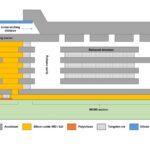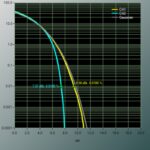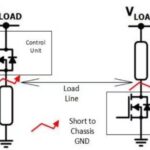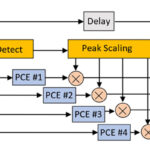A transimpedance amplifier (TIA) converts current to voltage. Transimpedance amplifiers can be used to process the current output of photodiodes, pressure transducers, accelerometers, and other types of sensors to a voltage formatted as a useable signal output. TIAs provide simple linear signal processing using an operational amplifier and a resistor for dissipating current. Figure 1 shows a basic transimpedance amplifier circuit.
Figure 1: A transimpedance amplifier is an op amp and a resistor that convert current to voltage. (Chaniotakis and Cory. 6.071 Spring 2006)
In Figure 1, Iin represents the current output from a sensor and the gain (sensitivity) is the resistance, R. Using Kirchhoff’s Current Law (KCL), the sum of all currents flowing into a node is zero. If we assume that the op amp is ideal (meaning no current flows into the op amp +/- inputs), KCL at node N1 gives us the equation in Figure 2, resulting in a voltage output:
Figure 2: Equation for Figure 1, using KCL at Node N1, and assuming an ideal op amp. I1 is current flow with respect to Node N1. (Chaniotakis and Cory. 6.071 Spring 2006)
If high sensitivity is required, the transimpedance amplifier may use a “T feedback network” as shown in Figure 3 below. The feedback takes part of the amplified output from the input so that gain is constrained more by the predictable feedback network and less by the open loop gain.
Figure 3: A highly sensitive TIA can be constructed with a resistor network known as a “T network.” (Chaniotakis and Cory. 6.071 Spring 2006)
Here, VOUT is a function of I1 and the resistor network:
Figure 4: The relationship between VOUT and I1 becomes the above equation when the T network is inserted in the circuit for a sensitive TIA as in Figure 3. (Chaniotakis and Cory. 6.071 Spring 2006)
The accuracy of transimpedance amplifiers depends on factors such as signal conditioning and linearity, hysteresis, and temperature. Depending on the application and environmental conditions, additional circuitry such as noise filters may be inserted to achieve improved accuracy. Unwanted signals are removed using active filters (using gain and feedback) or passive filters (using resistors and capacitors.) Small reverse current flows are removed using an instrumentation amplifier.
Selecting a Transimpedance Amplifier
Of course, you can purchase a TIAs as an integrated chip. What specifications should you look at for your application? Primary parameters for consideration in selecting a transimpedance amplifier are bandwidth, noise, signal bandwidth, and gain. Avoid a sensor with high capacitance and avoid creating a capacitance between your sensor and the TIA. Avoid a TIA with high voltage noise (nV/√Hz) or high current noise (pA/√Hz), and factor in the impedance of your sensor at the highest operating frequency of that sensor such that the product of voltage noise (of the TIA op amp), current noise (of the TIA op amp), and the aforementioned impedance of your sensor at the highest frequency are as low as you can get them.
For instance, assume your application involves a photodiode. Photodiodes convert light into current, which a transimpedance amplifier then converts to voltage with a transimpedance amplifier. (Many microcontrollers and industrial controllers such as PLCs accept only DC voltage signals as inputs.) The photodiode itself has noise, and you can calculate the total noise in the signal chain on its way to the controller by combining the noise from the individual components, i.e. the photodiode, the op-amp, and the resistor. This calculation is not a simple addition problem, includes thermal (Johnson noise), Boltzmann’s constant, and shunt resistance in the photo diode, among other things, and is covered in depth elsewhere.[i]
Transimpedance amplifiers can be tricky in that it’s a delicate balancing act between trade-offs. So many factors work together in a complicated way to affect a TIA’s performance with respect to behavior like response, overshoot, and noise, that choosing the “best” TIA can be a daunting effort. One can always make their own TIA as an op amp circuit and tune it to their application, but with some effort, you can find one ready-made that suits your application with an eye on some of the caveats mentioned here.
[i] Kay, Art. Operational Amplifier Noise: Techniques and Tips for Analyzing and Reducing Noise. Waltham, MA: Newnes, 2012. Print.
The post FAQ: Converting current to voltage; the role of transimpedance amplifiers appeared first on Analog IC Tips.










